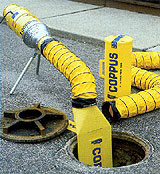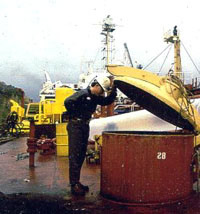Shipyard Employment eTool
Ship Repair » Painting and Other Coatings

Hot Work in Confined Spaces, Fire Watch, Hot Work in Enclosed Space, Hot Work in Other Locations, Ventilation, Labeling, Rescue Team
Paints and other preservative coatings may contain toxic and flammable materials such as hydrocarbon solvents (e.g., Toluene and MEK), epoxy resins, and anti-fouling paints. Surface coating applications may release large quantities of these materials into the air, causing possible fire and explosion hazards as well as toxic inhalation and skin absorption hazards.
Review Confined/Enclosed Spaces and Other Dangerous Atmospheres and Hot Work Operations before proceeding with this section.
Coating applications may expose workers to the following hazards:
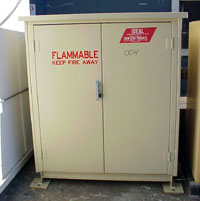
Potential Hazard
Fire and explosion hazards associated with paint and coating applications depend upon the flashpoint and volatility of the substance. Lower flashpoint liquids (less than 80º F) present greater hazards and require additional controls.
Requirements and Example Solutions
The following control requirements and hazard solutions have been separated into two categories:
- Liquids/substances with flashpoints above 80º F
- Liquids/substances with flashpoints below 80º F
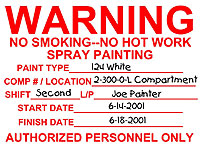
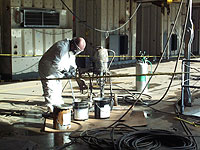
Liquids/substances with flashpoints 80º F and above
- Hot work must not be performed in the space or adjacent spaces during painting operations. [29 CFR 1915.36(a)(1)]
- Rags soaked with solvents must be kept in covered metal containers. [29 CFR 1915.36(a)(3) and 29 CFR 1915.81(a)(5)]
- Paints, thinners, and solvents must be kept in fire-resistant covered containers when not in use. [29 CFR 1915.81(a)(5)]
- Smoking and open flames must be prohibited in the area. [29 CFR 1915.36(a)(1)]
- Arcing and sparking equipment and tools must not be used. [29 CFR 1915.36(a)(1)]
- Equipment that may generate static electricity (e.g., ventilation systems) must be grounded/bonded. [29 CFR 1915.35(a)(4)]
- Only explosion-proof lights must be used. [29 CFR 1915.36(a)(4)]
- Adequate ventilation must be maintained in storage, mixing, and transfer areas. [29 CFR 1915.36(a)(2)]
- Frequent tests must be required during painting operations to determine if air concentrations are below 10 percent of the LEL. [29 CFR 1915.36(a)(2)]
- Suitable fire fighting equipment must be immediately available. [29 CFR 1915.36(a)(6)]
- 30-gallon drums and containers of flammable or toxic liquids must be placed in an area where they will not be subject to physical damage. [29 CFR 1915.173(d)]
- 55-gallon drums containing flammable or toxic liquids must be surrounded by dikes or pans. [29 CFR 1915.173(e)]
- Power and lighting cables must be inspected by a person competent to evaluate electrical hazards and ensure there are no connections within 50 feet of the painting operations (not necessarily the Shipyard Competent Person). [29 CFR 1915.36(a)(5)]
- Spills of solvents should be cleaned up immediately.



Liquids/substances with flashpoints below 80º F
When paints and tank coatings are dissolved in highly volatile, flammable solvents with flash points below 80º F, the following additional precautions must be taken:
- Sufficient exhaust ventilation must be provided to keep the concentration of solvent vapors below 10 percent of the lower explosive limit (LEL). Frequent tests must be made by a competent person to ascertain concentrations. [29 CFR 1915.35(b)(1)]
- If the concentration exceeds 10 percent of the LEL, work must be stopped until the concentration falls below 10 percent of the LEL. [29 CFR 1915.35(b)(2)]
- Ventilation must be continued after painting is complete until the space or compartment is "gas-free." [29 CFR 1915.35(b)(3)]
- Exhaust ducts must discharge clear of working areas and away from sources of possible ignition. [29 CFR 1915.35(b)(4)]
- Periodic tests must be conducted by the Shipyard Competent Person to ensure the exhausted vapors are not accumulating in other areas within or around the vessel or dry dock. [29 CFR 1915.35(b)(4)]
- Explosion-proof motors, fan blades, and portable air ducts must be non-ferrous. [29 CFR 1915.35(b)(5)]
- All footwear worn during painting operations must be non-sparking. [29 CFR 1915.35(b)(9)]
- PPE must not produce static electrical sparks. [29 CFR 1915.35(b)(9)]
- No matches, lighted cigarettes, cigars, pipes, cigarette lighters, or other ferrous articles are allowed into the work area. [29 CFR 1915.35(b)(10)]
- All solvent drums taken into the compartment where painting operations are being performed must be placed on nonferrous surfaces and grounded to the vessel. [29 CFR 1915.35(b)(11)]
- All metallic parts of paint spraying equipment must be grounded and bonded to the vessel. [29 CFR 1915.35(b)(12)]

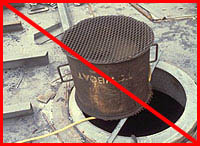
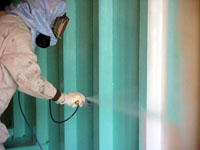
Potential Hazard
Toxic vapors and mists from paints and paint solvents may present significant health hazards due to inhalation during painting operations. These vapors may accumulate in low-lying areas as well as enclosed spaces where they displace the air and lower the oxygen content.
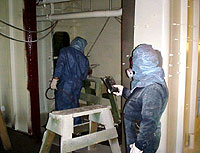
Requirements and Example Solutions
- A hazard assessment must be conducted to determine the proper selection of respirators. [29 CFR 1915.152(b)]
- The components of epoxy, isocyanate, anti-fouling, and coal tar pitch paints may be particularly dangerous to workers' health and call for special precautions.
- Many of these paints cause respiratory and skin sensitization and allergic reactions, which may be life threatening.
- Respirators must be used in accordance with the PPE section 29 CFR 1915.154.
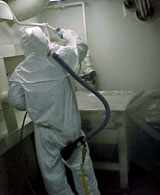
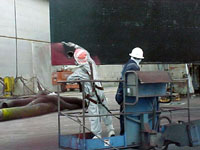
When paints are mixed with toxic vehicles or when solvents are sprayed the following respiratory protection procedures are required:
- Continual Air Monitoring
- The Shipyard Competent Person (SCP), Certified Marine Chemist (CMC), or Certified Industrial Hygienist (CIH) may require continual monitoring to determine that vapor/mist air concentrations are within the PELs and below IDLH levels while workers are in the area.
- If the concentrations are above appropriate levels, additional administrative controls (e.g., exposure time limits), engineering controls (e.g., ventilation), or PPE (e.g., respirators) are required.
- Use of Airline Respirators
- Airline respirators are required in confined spaces to protect employees who are continuously exposed to toxic materials during coating operations. [29 CFR 1915.35(a)(1)(i)]
- Airline respirators are required in enclosed spaces to protect workers when mechanical ventilation is not provided, [29 CFR 1915.35(a)(1)(ii)] or when the flash point of the paint or solvent is less than 80º F. [29 CFR 1915.35(b)(13)]
- Use of Air Purifying Respirators (Filter Respirators)
- In tanks and compartments where mechanical ventilation is provided, employees continuously exposed must be protected by filter respirators, at a minimum; in accordance with Subpart I (29 CFR 1915.154). [29 CFR 1915.35(a)(1)(ii)]
- In large and well-ventilated areas, employees exposed to spray painting must be protected by filter respirators in accordance with Subpart I (29 CFR 1915.154). [29 CFR 1915.35(a)(1)(iii)]
- All employees doing exterior spray painting with material containing solvents with flash points below 80º F must be protected by suitable filter cartridge-type respirators, at a minimum; in accordance with Subpart I (29 CFR 1915.154). [29 CFR 1915.35(b)(14)]
- Employees entering compartments where spray painting is being done with paints containing solvents with a flash point below 80º F, for a limited time, must be protected with filter cartridge type respirators, at a minimum; in accordance with Subpart I (29 CFR 1915.154). [29 CFR 1915.35(b)(13)]
When coatings are applied by non-spray methods, the following respiratory protection procedures are required:
- Air Purifying Respirators (Filter Respirators).
- When brush application of paints containing toxic solvents is done in confined spaces or in other areas where lack of ventilation creates a hazard, filter respirators at a minimum in accordance with Subpart I (29 CFR 1915.154). [29 CFR 1915.35(a)(2)]
Additional Resources
- Ventilation. See the Confined or Enclosed Space: Ventilation module.
- Respiratory Protection. OSHA eTool.
- Inspection procedures for the Respiratory Protection Standard. OSHA Directive CPL 02-00-158, (June 26, 2014).
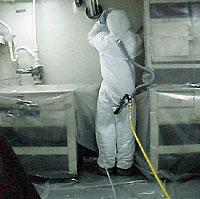
Potential Hazards
Employees working with paint or paint solvents containing toxic or corrosive materials are at risk if skin or eye contact occurs. Precautions must be taken to prevent such contact in order to avoid:
- Organ damage through chemical absorption through the skin or eyes
- Chemical burns, irritation, sensitization, and allergic reaction to skin or eyes
- Ingestion of food contaminated with toxic materials due to poor hygiene
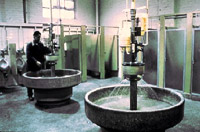
Requirements and Example Solutions
- A hazard assessment for each job and condition must be conducted to determine proper selection of PPE. [29 CFR 1915.152(b)] This assessment should include:
- The nature of the hazardous materials involved
- Anticipated concentrations of the materials
- How the materials will be used
- Performance of the PPE
- Actions workers will perform
- All body parts, including face, eyes, head, and hands must be protected from highly volatile paints. [29 CFR 1915.35(b)(9)]
- Spills or other releases of painting materials should be cleaned up as soon as possible.
- Washing facilities (such as quick-drenching shower) must be available in case employees have skin contact with paint and paint solvents that may be absorbed through the skin. [29 CFR 1915.88(e) and 29 CFR 1915.151(c)]
- Workers must be trained about potential hazards involved with the materials they work with, as well as precautions; in accordance with Hazard Communication Standard. [29 CFR 1915.1200]
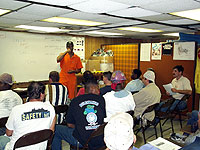
Additional Information
- Hazard Communication Guidelines for Compliance. OSHA Publication 3111, (2000). Hazard Communication. OSHA Safety and Health Topics Page.

- Fixed or portable eye wash stations/safety showers should meet ANSI Z358.1-1998: Emergency Eye Wash and Shower Equipment.
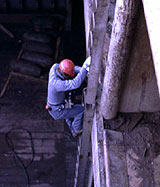
Potential Hazards
Workers performing painting operations are exposed to slippery conditions and tripping hazards. Workers are at risk of:
- Slipping off oily and greasy ladders
- Slipping and falling on oily decks
- Tripping over equipment, hoses, and vessel structures
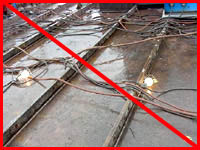
Requirements and Example Solutions
- Spills must be cleaned up immediately. [29 CFR 1915.81]
- Visual Inspection will be conducted. See Confined or Enclosed Space module.
- Adequate illumination will be provided. See Confined or Enclosed Space module.
- Housekeeping will be maintained as described in 29 CFR 1915.81.


Potential Hazards
Fall hazards are a leading cause of shipyard fatalities.
Shipyard employees are often required to work in dangerous environments that may include fall hazards. Accidents involving elevation equipment such as ladders, scaffolds, and aerial lifts are often serious, even fatal.
Deck Openings and Edges
- Falls from deck openings
- Falls into open holes

Scaffolds
- Falls from ladders
- Falls from scaffolds
Requirements and Example Solutions
Guarding of Deck Openings and Edges
- Openings and deck edges must be guarded. [29 CFR 1915.73]
- Flush manholes and other small openings must be guarded after opening. [29 CFR 1915.73(b)]
- During the installation of guards on large openings and deck edges, fall protection (harness with lanyard) must be used. [29 CFR 1915.73(d)]
- Openings must be guarded or planked when floor plates or gratings (e.g. bilges, engine rooms, pump rooms, machinery spaces) are removed. [29 CFR 1915.73(f)]
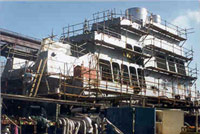
Fall Protection for Scaffold Work
- Guardrails or other appropriate fall protection must be used when working on scaffolds 5 feet above surfaces. [29 CFR 1915.71(j)]
- Fall protection must be used during the installation of guards on scaffolds. [29 CFR 1915.73(d)]
- Fixed or portable eye wash stations/safety showers should meet ANSI Z358.1-1998: Emergency Eye Wash and Shower Equipment.
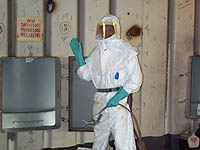
Potential Hazards
The use of high-pressure paint equipment may expose the operator, as well as other workers, to the following hazards:
- Contact with high-pressure painting equipment
- Contact by uncontrolled high-pressure hoses
- Contact with air leaks from high-pressure equipment
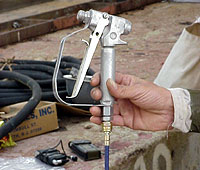
Injuries associated with these hazards include:
- Loss of body parts (e.g., fingers, hands, etc.)
- Lacerations
- Burns
- Loss of sight
Requirements and Example Solutions
- Access to the area should be controlled.
- Avoid contact with high-pressure nozzle.
- Maintain high-pressure spray equipment according to the manufacturer's requirements.
- Inspect hoses and connections before use.
- Use paint pots with appropriate pressure regulators/ratings.
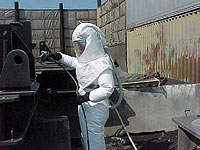
Potential Hazards
Environmental conditions such as temperature, humidity, and air movement within the work area may cause hazards. A combination of PPE use, heat-producing equipment, work activity, and environmental conditions can cause temperature-related illnesses.
Heat-related illnesses include:
- Heat Stress
- Heat Stroke
- Heat Cramps
- Dehydration
Cold-related illnesses include:
- Hypothermia
- Frostbite
Additional Resources
- OSHA Technical Manual (OTM). OSHA Directive TED 01-00-015 [TED 1-0.15A], (January 20, 1999). Identifies heat stress as part of the evaluation process in the following:
- Heat Stress. Contains useful sections on the signs and symptoms of heat stress, sampling methods, control suggestions, and guidelines for investigating heat stress in the workplace.
- Heat Stress: General Work-Place Review. Contains a list of factors that should be considered when investigating heat stress in the workplace.
- Heat Stress-Related Illness or Accident Follow-up. Includes a brief list of questions to answer when investigating a heat stress illness or accident.
- Measurement of Wet Bulb Globe Temperature. Provides a brief overview of how to measure and calculate the Wet Bulb Globe Temperature.
- Heat Stress. Contains useful sections on the signs and symptoms of heat stress, sampling methods, control suggestions, and guidelines for investigating heat stress in the workplace.
- Occupational Heat Exposure. OSHA Safety and Health Topics Page.
- Heat Stress.

Example Solutions
Maritime Labor/Industry recommends the following for heat-related illnesses
- Plenty of fluids
- Frequent breaks
- Ice vest
- Shaded or cooled break areas
- Ventilation
- Awareness training
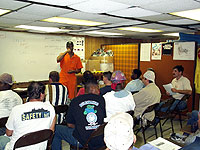
Maritime Labor/Industry recommends the following for cold-related illnesses
- Appropriate insulation (PPE)
- Warming areas for breaks
- Awareness training

Potential Hazards
Employees who work with or around electrical equipment have an increased risk of getting shocked or electrocuted due to:
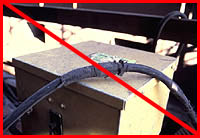
- Exposed energized electrical parts;
- Open lighting parts (such as broken bulbs, exposed conductors);
- Damaged insulation on power cords.
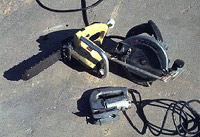
Requirements and Example Solutions
- Portable electrical tools must be grounded or double-insulated. [29 CFR 1915.132(a)]
- Temporary lighting must be grounded and explosion-proof. [29 CFR 1915.36(a)(4) and 29 CFR 1915.82(b)(8)]
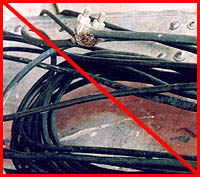
- Power and lighting cables must be inspected by a person competent to evaluate electrical hazards. (Note: This is not the Shipyard Competent Person). [29 CFR 1915.36(a)(5)]
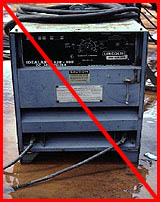
- All electrical tools or equipment should undergo a visual inspection before use.
- All portable electric hand tools and temporary lighting systems should use Ground Fault Circuit Interrupters (GFCI).
- Electrical tools and equipment should correspond with the requirements of the job.
- Electrical equipment and tools should be used with proper circuit protection for the voltage and amperage used.
- Only qualified electricians should attempt repair of electrical tools and equipment.
- A Ground Assurance Program should be in place for all electrical tools and equipment used including:
- Records of tools inspected and repaired;
- Records of electrical boxes inspected and repaired;
- Records of electrical extension cords inspected and repaired; and
- Recall of records of the above.
- The requirements of the Ground Assurance Program should be performed on a regular basis.

Potential Hazards
When working in confined or enclosed spaces, workers may become trapped and unable to exit due to:
- Improperly located equipment blocking egress.
- Ventilation ducts and hoses running through an opening blocking egress.

Requirements and Example Solutions
- When employees work in confined spaces with limited access, the access must not be blocked or impeded by ventilation ducts, hoses, or other equipment. [29 CFR 1915.76(b)(2)]
- More than one means of access must be provided where practical. [29 CFR 1915.76(b)(1)]
- Additional openings should be provided for ducts, hoses, and other equipment.
